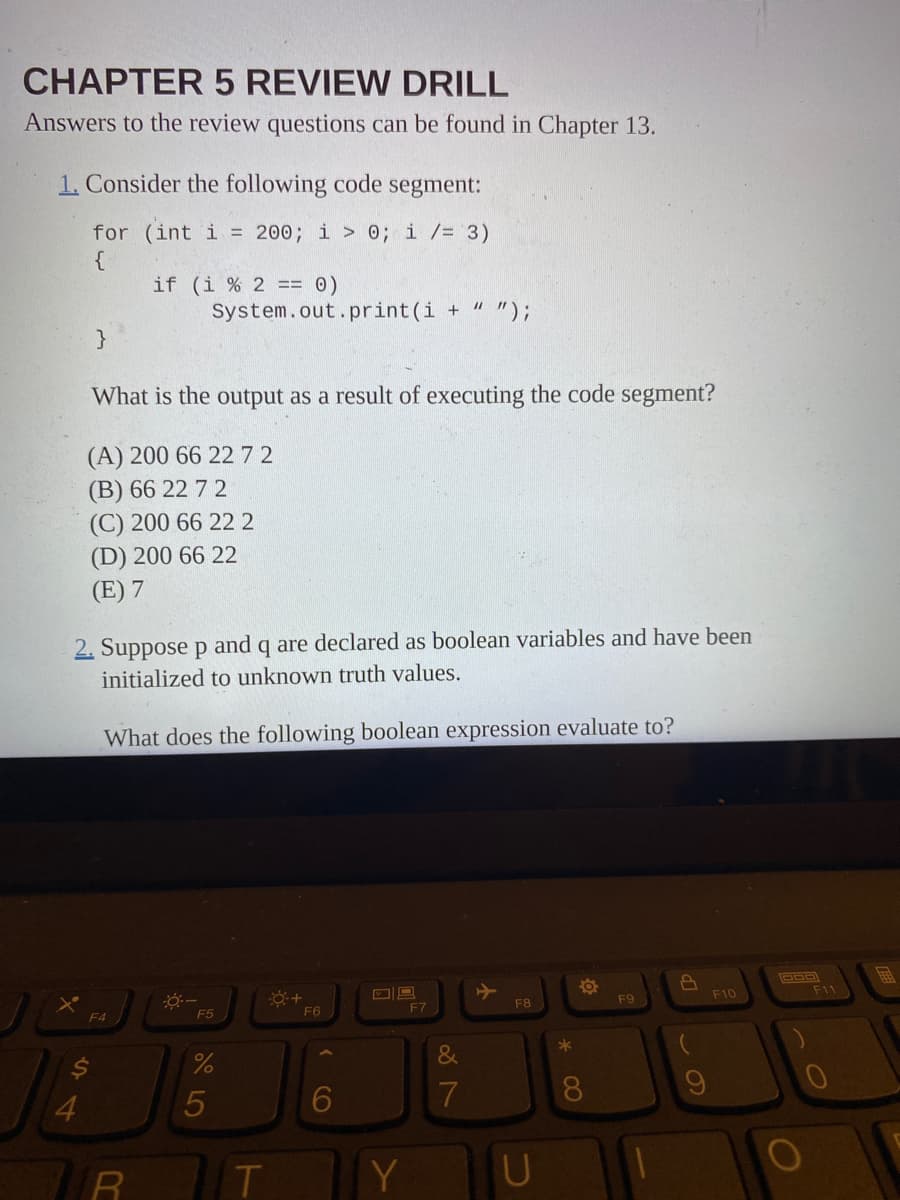From this explanation I was given for this code segment: Explanation: Iteration 1: i = 200 After entering the loop: i %2 == 0 i.e 200%2 == 0 will be true , So prints 200 Iteration 2: i = i/3 = 200/3 = 66 After entering the loop: i %2 == 0 i.e 66%2 == 0 will be true , So prints 66 Iteration 3: i = i/3 = 66/3 = 22 After entering the loop: i %2 == 0 i.e 22%2 == 0 will be true , So prints 22 Iteration 4: i = i/3 = 22/3 = 7 After entering the loop: i %2 == 0 i.e 7%2 == 0 will be false , So 7 is not printed Iteration 5: i = i/3 = 7/3 = 2 After entering the loop: i %2 == 0 i.e 2%2 == 0 will be true , So 2 is printed Iteration 6: i = i/3 = 2/3 = 0 Does not meet the condition, so exits from the condition. I don’t understand why there are 6 different iterations in this code segment and what i > 0 in the for loop and System.out.print(i + “ “) mean. Can you give me an in depth explanation as to why these things occur?
From this explanation I was given for this code segment: Explanation: Iteration 1: i = 200 After entering the loop: i %2 == 0 i.e 200%2 == 0 will be true , So prints 200 Iteration 2: i = i/3 = 200/3 = 66 After entering the loop: i %2 == 0 i.e 66%2 == 0 will be true , So prints 66 Iteration 3: i = i/3 = 66/3 = 22 After entering the loop: i %2 == 0 i.e 22%2 == 0 will be true , So prints 22 Iteration 4: i = i/3 = 22/3 = 7 After entering the loop: i %2 == 0 i.e 7%2 == 0 will be false , So 7 is not printed Iteration 5: i = i/3 = 7/3 = 2 After entering the loop: i %2 == 0 i.e 2%2 == 0 will be true , So 2 is printed Iteration 6: i = i/3 = 2/3 = 0 Does not meet the condition, so exits from the condition. I don’t understand why there are 6 different iterations in this code segment and what i > 0 in the for loop and System.out.print(i + “ “) mean. Can you give me an in depth explanation as to why these things occur?
C++ Programming: From Problem Analysis to Program Design
8th Edition
ISBN:9781337102087
Author:D. S. Malik
Publisher:D. S. Malik
Chapter15: Recursion
Section: Chapter Questions
Problem 8SA
Related questions
Question
100%
From this explanation I was given for this code segment:
Explanation:
Iteration 1: i = 200
After entering the loop: i %2 == 0 i.e 200%2 == 0 will be
true
, So prints 200
Iteration 2: i = i/3 = 200/3 = 66
After entering the loop: i %2 == 0 i.e 66%2 == 0 will be
true
, So prints 66
Iteration 3: i = i/3 = 66/3 = 22
After entering the loop: i %2 == 0 i.e 22%2 == 0 will be
true
, So prints 22
Iteration 4: i = i/3 = 22/3 = 7
After entering the loop: i %2 == 0 i.e 7%2 == 0 will be
false
, So 7 is not printed
Iteration 5: i = i/3 = 7/3 = 2
After entering the loop: i %2 == 0 i.e 2%2 == 0 will be
true
, So 2 is printed
Iteration 6: i = i/3 = 2/3 = 0
Does not meet the condition, so exits from the condition.
I don’t understand why there are 6 different iterations in this code segment and what i > 0 in the for loop and System.out.print(i + “ “) mean. Can you give me an in depth explanation as to why these things occur?

Transcribed Image Text:CHAPTER 5 REVIEW DRILL
Answers to the review questions can be found in Chapter 13.
1. Consider the following code segment:
for (int i = 200; i > 0; i /= 3)
{
}
4
$
What is the output as a result of executing the code segment?
(A) 200 66 22 72
(B) 66 22 72
(C) 200 66 22 2
(D) 200 66 22
(E) 7
2. Suppose p and q are declared as boolean variables and have been
initialized to unknown truth values.
What does the following boolean expression evaluate to?
F4
if (i % 2 == 0)
R
System.out.print(i + " ");
F5
%
5
T
Q+
F6
CO
6
Y
F7
&
7
F8
*
☀
8
F9
8
F10
000
F11
Expert Solution
This question has been solved!
Explore an expertly crafted, step-by-step solution for a thorough understanding of key concepts.
Step by step
Solved in 2 steps

Knowledge Booster
Learn more about
Need a deep-dive on the concept behind this application? Look no further. Learn more about this topic, computer-science and related others by exploring similar questions and additional content below.Recommended textbooks for you

C++ Programming: From Problem Analysis to Program…
Computer Science
ISBN:
9781337102087
Author:
D. S. Malik
Publisher:
Cengage Learning

C++ Programming: From Problem Analysis to Program…
Computer Science
ISBN:
9781337102087
Author:
D. S. Malik
Publisher:
Cengage Learning